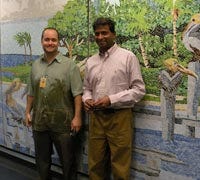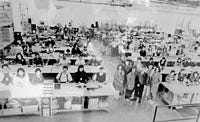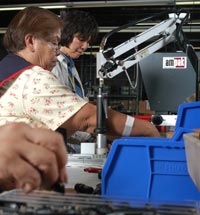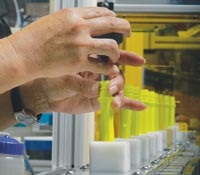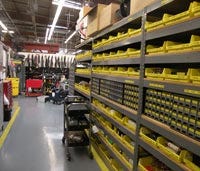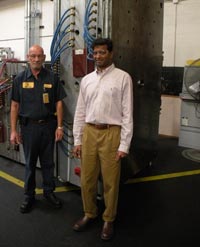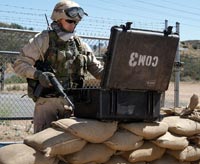From its beginning in a garage to being a global manufacturer of lights and protective cases, Pelican employees take pride in helping safeguard customers’ equipment, and guarantee their products for life.
June 3, 2009
From its beginning in a garage to being a global manufacturer of lights and protective cases, Pelican employees take pride in helping safeguard customers’ equipment, and guarantee their products for life.
Most manufacturers might think that guaranteeing a product for life would eliminate repeat purchases, or be too costly to implement. But by expanding the market itself and becoming a more efficient molder, Southern California’s Pelican Products (Torrance) keeps experiencing growth, even in a slowed economy. And all employees know just how important the protective cases and lighting tools they manufacture are to the company’s customers, whether it’s a recreational hunter, a professional photographer, or a government agency.
|
In 1976, Dave Parker, the company’s founder and former president, started Pelican Products with his wife Arline in the couple’s garage when they decided to make scuba diving floats that weren’t then on the market. In the evenings, after working at his industrial design and advertising business, Dave built his own equipment and handled the float assembly while Arline boxed, billed, and mailed the floats to customers responding to ads placed in scuba diving magazines. The company quickly expanded, and the first flashlight was created in 1977, with the first protective case coming shortly after. Business has steadily grown for the company, now owned by a private equity group.<
“We have several employees who have been here a long time,” says Keith Swenson, Pelican’s marketing and advertising analyst, who, along with Shailesh Bambardekar, the director of operations, leads us on the tour. A photo of the employees on the shop floor taken during the company’s early days shows that, aside from a few retirees, most of the original employees are still there. Only a year and a half ago, case production could be completed in 24/5 shifts, but now the 22 50- to 1800-ton molding machines are running 24/7 to meet demand. The average time a case spends in the facility is just 48 hours.
|
“Our business has grown 20%-plus every year, but our head count hasn’t grown,” says Bambardekar. “So we’re just getting more out of what we have every year, and that’s the key.” In the past four years, the company has seen average growth of 23%, and plans are for 2009 to be a year of improvement (yes, you read that correctly), with a more modest growth projection of 8-9%. “Right now, inventory is the same as it was four years ago, but revenue has doubled.”
Innovation lights the way
In the 15,000-ft2 assembly area we visit first, brightly colored flashlight parts, hot stamped with the name and logo of a police department, are being put together by assembly personnel whose numbers vary depending on the jobs running. Kanban cards are picked up every 2 hours to replenish the assembly cell, and a flashlight is finished every 13-20 seconds. The company developed this flashlight when the Los Angeles Police Dept. was interested in a lightweight, rechargeable, durable, and fire-resistant light that would provide increased brightness for its officers. “They put out a request for proposal for us and our competitors, and the competitors told us ‘good luck.’”
In January, Pelican announced the acquisition of Hardigg Industries (South Deerfield, MA), whose rotomolded cases used to compete with Pelican products. The deal will help Pelican access Hardigg’s deep selling channels with the military. With a contract manufacturing facility in Crottendorf, Germany and a distribution center in Barcelona, Spain, Pelican looks to increase sales globally and domestically, growing to include reverse logistics product packaging and a greater retail presence.
Pelican took on the challenge, selecting high-impact Xenoy PBT from Sabic for the body and shroud, and nylon for the lens. The flashlights use a lithium ion battery and have an LED light with patented “recoil” technology, which uses a deflector to shoot the light back for greater brightness. The body, shroud, and lens are molded in the back of the facility, staged in the middle, and assembled in the front, with the electronics manufactured in China. Including the battery, Pelican was able to lower the weight of the light to about 10 oz, and the demand for this flashlight quickly spread.
Change molds, not colors
Machine uptime has improved every year, thanks in part to a well-organized maintenance room added nine months ago. A consignment program with Cincinnati Milacron gives the maintenance crew access to clearly labeled manuals, fuses, belts, and other spare parts.
Pelican works with Chinese toolmakers to supply molds, but has several machining centers in the plant to perform mold maintenance, make tooling modifications, and create cavity inserts. A new Akira-Seiki Performa V5 working on a latch modification was purchased as part of the $6 million-$7 million capital budget that Pelican invested back into machinery last year.
Vital Stats Facility size: 200,000 ft2 |
Four years ago, mold changes took 8 hours. Pelican’s new quick-mold-change system, developed in-house, cuts the time to 15-20 minutes. Instead of hoisting all the molds over the tiebars from the top, the molds slide in from the side. Metal carts are used for smaller molds, and more elaborate mechanical bases with a push/pull pulley and chain are used for the big molds. “Every mold that goes into the machine has the same platen size,” says Bambardekar. “With the mold cart in position, the rollers are the same size as the platen.”
Some of the smaller machines go through around 20 mold changes in a day because Pelican has found that it’s easier to change the mold than change the color. Of the 200 molds used, about a fifth are used every day. Switching from purging with ABS to using a chemical purging compound has also helped Pelican trim downtime.
The $7.5 million ERP system Pelican purchased last July is also essential to the company’s ability to utilize machines to the fullest by keeping jobs of the same color sequenced together. After orders are entered, a planning horizon of 32 hours is frozen, and another set of requirements is planned for when the next set of orders comes in. “Every item has a prescribed order point. Once the stock level drops below that order point, it triggers you to make a batch,” says Bambardekar. “Then, in a given day, you have these different production requirements that the ERP system recommends. Then it’s up to the planners to sequence them properly.”
A case study in toughness
While Pelican’s flashlights and cases were developed around the same time, about 70% of the company’s business is protective cases. In addition to design details like ribs protecting latch areas from impact, the secret to Pelican’s durable yet lightweight case design is the structural foam walls. Foaming agents are added to the proprietary blend of polypropylene, of which an estimated 15 million lb will be used in 2009. Stored outside in silos, the material comes to the presses, and after the runners go through the grinder and the fines are removed, up to 25% regrind is added to the black cases using Novatec mixers.
Testimonials on the company’s website show that the cases can survive the jaws of lions in Zimbabwe, pack horses tumbling into rivers in Northern India, terrorist vehicle bombings in Pakistan, and even the maverick missiles that destroyed an entire helicopter in Iraq. Aside from minor burns and a broken latch, a case full of important equipment including satellite phones, not to mention a block of C-4 explosive, was completely intact, and the equipment worked throughout the soldier’s stay in Iraq. The company stands by its pledge of “you break it, we replace it ... forever,” but instead of having to replace cases, they mostly receive orders from satisfied customers wanting more.
Molding cycles for the cases take up to 4 minutes for the large ones, and in most of the cells, a six-axis Fanuc robot grabs the combined halves of the case, moves them to a retractable blade to cut the sprue, and sets them down in the assembly area, where pins are hammered in the hinges manually. In the time that the next case is molded, the previous one is fully assembled and boxed up, ready to be shipped, with no intermediate storage necessary. New ideas are always tried out on one cell, and if they work out, are implemented in the other cells.
As we walk through the back of the facility where the cleverly named Cincinnati Milacron molding machine cells are lined up, Swenson points at “Belle” and tells us that, despite his job as a marketing and advertising analyst, he started at Pelican working on the assembly line at that particular press. As part of Pelican’s orientation and training process, regardless of the type of job, employees spend the first two weeks on the manufacturing floor to gain knowledge of and appreciation for the craftsmanship that goes into the products.
“If you’re a new person, you don’t really know anybody, and with this orientation process, you get to know people,” says Swenson. “There are people I worked with when I started here that I still say ‘hi’ to in the back, and I know them because I was part of that process.”
Pelican also has made several environmentally friendly choices, including a $70,000 high-efficiency lighting project and a shift in energy consumption patterns to take advantage of rebates. “All of our products are RoHS compliant,” says Bambardekar. �“On our own, we’re working on the final stages of becoming a Sony Green Partner, which is a very big achievement.”
Through the years, Pelican has experienced many big achievements, but perhaps none greater than providing customers, including soldiers, firefighters, and police, with the best tools and protection available. —[email protected]
WEB EXTRA
Watch Pelican’s 1800-ton Colossus molding machine installation, condensed into 3 minutes—click on “Colossus is Coming.”
About the Author(s)
You May Also Like

